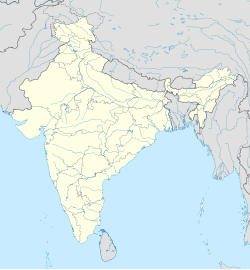Bagelkhand
Baghelkhand | |
|---|---|
Top to Bottom; Left to Right: Purwa Falls, Govindgarh Palace, Ramghat at Chitrakoot, Chandreh Temple at Rampur Naikin, Virateshwara Temple at Sohagpur and Keoti Falls | |
 Location of Baghelkhand in India | |
| Coordinates: 24°30′N 81°12′E / 24.5°N 81.2°E | |
| Country | |
| State | Madhya Pradesh and Uttar Pradesh |
| Covering territory |
|
| Languages | Bagheli language |
| Area | |
• Total | 42,179 km2 (16,285 sq mi) |
| Population (2011) | |
• Total | 10,351,135 |
| • Density | 250/km2 (640/sq mi) |
Bagelkhand or Baghelkhand is a proposed state and a mountain range in central India that covers the northeastern regions of Madhya Pradesh and a small area of southeastern Uttar Pradesh.
History
[edit]Dahala
[edit]Baghelkhand was known as Dahala in the 6th–12th century. Rewa State was founded in the area circa 1140. The area's current name refers to the Vaghela dynasty who ruled this state.[1]
Bagelkhand Agency
[edit]The Bagelkhand Agency was a British political unit which managed the relations of the British with a number of autonomous princely states existing outside British India, namely Rewa and 11 minor states, of which the most prominent were Maihar, Nagod and Sohawal. Other principalities included Jaso, Kothi, Baraundha (aka Patharkachhar) as well as the Kalinjar Chaubes, consisting of the princely estates of Paldeo, Kamta-Rajaula, Tarauwhan, Pahra and Bhaisaunda.[2]

Geography
[edit]Bagelkhand is a region located in central India, characterized by its varied topography. It is bordered by the fertile Indo-Gangetic plains to the north and east, the Bundelkhand region to the west, and the Vindhya mountain range to the south.[1] This geographical positioning gives Bagelkhand a diverse landscape that includes plains, hills, and forested areas, influencing its climate, agriculture, and settlement patterns.

Administration
[edit]The Bagelkhand region is currently divided between the Indian states of Madhya Pradesh and Uttar Pradesh. In Madhya Pradesh, it includes the districts of Rewa, Satna, Shahdol, Sidhi, Anuppur, and Umaria, which collectively form the core of the historical Bagelkhand territory. In Uttar Pradesh, the region extends into parts of Chitrakoot, as well as the southern portions of Sonbhadra and Mirzapur districts.[1]
The administrative boundaries of Bagelkhand do not constitute a formal political unit but represent a cultural and historical region with shared linguistic, historical, and social characteristics. Despite the division between two states, the region maintains a sense of regional identity, especially through the Bagheli language, local traditions, and shared history under the Baghela Rajput rulers.
Demographics
[edit]The inhabitants of Bagelkhand are called Bagheli and they speak the Bagheli language which is also designated as a dialect of Hindi.[1]
References
[edit]- ^ a b c d "Baghelkhand | historical region, India". Encyclopedia Britannica. Retrieved 30 April 2020.
- ^ Malleson, G. B. An historical sketch of the native states of India, London 1875, Reprint Delhi 1984
- ^ "C-1 Population By Religious Community". censusindia.gov.in. Retrieved 18 March 2022.
- ^ "C-16 Population By Mother Tongue". censusindia.gov.in. Retrieved 18 March 2022.









